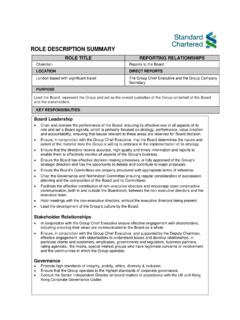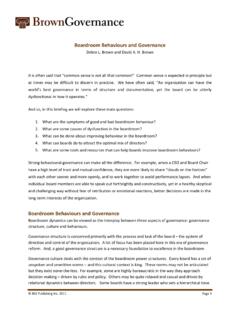Transcription of Key Issues When Considering a Spin-off - Sullivan & Cromwell
1 Key Issues When Considering a Spin-offIn his regular column, Frank Aquila drafts a sample memo to a board identifying the principal legal Issues to consider when determining whether to undertake a proposed Spin-off of a THE BOARDROOMCAPITAL MARKETS & CORPORATE GOVERNANCEJune 2015 | : The Board of DirectorsFROM: Frank AquilaRE: Issues When Considering a Spin-off As we have discussed, the Investor has proposed the Spin-off of a subsidiary of the Company. The Investor believes that the separation of the Company and the subsidiary into two independent, public companies will enhance shareholder value. The Investor premises its view on the fact that the Company and the subsidiary possess different business, financial and growth attributes, and that currently the capital markets do not fully value all of the elements of the combined business. In determining whether the proposed Spin-off is in the best interest of the Company and its shareholders, the Board will need to consider a range of legal, financial and practical factors.
2 FRANCIS J. AQUILAPARTNERSULLIVAN & Cromwell LLPF rank has a broad multidisciplinary practice that includes extensive experience in negotiated and unsolicited mergers and acquisitions, activist and takeover defense, complex cross-border transactions, global joint ventures and private equity transactions. He regularly counsels boards of directors and board committees on corporate governance matters and crisis management. 2015 Thomson Reuters. All rights reserved. 21 Practical Law The Journal | Transactions & Business | June 2015 Spin-offs are considered a distribution of dividends by the parent company and, therefore, the only approval needed to complete a Spin-off is that of the board of the parent company. As the Board decides whether to spin off the subsidiary, the directors are bound by their fiduciary duties to act in good faith, on an informed basis, and in the best interest of the Company and its shareholders. In making a decision to spin off a wholly owned subsidiary, the board of the parent company does not owe fiduciary duties to the newly spun-off company or to any prospective shareholders of the spun-off company.
3 Under the Delaware General Corporation Law (DGCL), companies are not required to obtain the approval of their shareholders before proceeding with a Spin-off . (This is the case in most states. However, shareholder approval for spin-offs is required in some states, such as in New York and Maryland.) A shareholder of a company can challenge the board s decision to engage in a Spin-off transaction as a breach of fiduciary duty. However, Delaware courts will generally apply the business judgment presumption (a very beneficial standard) to a board s decision to approve a transaction. Under the business judgment rule, it is extremely likely that the Delaware Court of Chancery would generally confirm a board s decision to undertake a Spin-off , provided that the board acted on an informed basis in the best interest of the company. Search Fiduciary Duties of the Board of Directors for a discussion of a director s core duties of care and loyalty and certain circumstances when the board holds heightened duties.
4 In Considering whether to approve the proposed Spin-off , the Board should consider: (i) the business purpose of the Spin-off ; (ii) tax consequences for the Company and its shareholders; (iii) the responsibilities of the Company s and the subsidiary s boards; (iv) corporate governance Issues ; (v) alternative methods for structuring a separation transaction; and (vi) the timeline of the Spin-off . This memo provides a broad overview of the principal legal Issues that should be considered in the Board s analysis. Search Spin-offs: Overview for a detailed explanation of Spin-off transactions, including information on alternative separation BUSINESS PURPOSE OF THE Spin-off Although utilized for many decades, spin-offs have become an increasingly popular business and financial tool in recent years. With many companies announcing Spin-off plans this year, it is likely that this so-called spinmania will continue. Many companies are opting to do a Spin-off because, as the Investor suggested, spin-offs often further the business purpose of increasing the combined market value of the parent company and the subsidiary.
5 Under the right circumstances, a Spin-off can release latent shareholder value by removing obstacles to both valuation and growth. A. INCREASING BUSINESS FOCUS Although a combined organizational structure has historically allowed the Company to take advantage of synergy opportunities, it appears that those significant cost synergies no longer exist to the extent that they once did. Nevertheless, the Board should consider whether the benefits of a combined organizational structure justify the negative cost of duplicative management structures. Since the Company and the subsidiary operate in unrelated business sectors with little crossover, the responsibility to operate the subsidiary in the framework of the Company s overall performance may be distracting managers from the Company s core operations and, as a consequence, limiting the subsidiary s growth. Furthermore, the external optics of controlling a business in an unrelated sector could cause brand confusion.
6 By spinning off the subsidiary, the Company s senior executives will be able to devote more attention and resources to the Company s core operations. The newly spun-off subsidiary will have its own directors and officers who can tailor their decision-making to the subsidiary s 2015 Thomson Reuters. All rights reserved. IN THE BOARDROOMCAPITAL MARKETS & CORPORATE GOVERNANCEJune 2015 | , needs and growth potential, without being constrained by any limitations imposed by the Company s core business. In addition, the equity compensation awarded to directors and officers of each entity will be tied directly to the performance of that entity and will serve as a more direct and meaningful incentive as intended. Under separate management, both the Company and the subsidiary could provide more directed and consistent messaging to current and prospective investors, collaborators, suppliers, customers and employees. B.
7 ALLEVIATING MARKET CONFUSION Since 1987, US GAAP (generally accepted accounting principles) have required companies to provide consolidated financial statements, which report the financial positions of the parent company and all the subsidiaries it controls as a single entity. The consolidated reporting can lead to investor confusion about the financial position of each stand-alone business. For example, General Electric s consolidated balance sheet is dominated by the activity of its financial services subsidiary, GE Capital, which its board has recently determined to sell. Although companies like General Electric often supplement consolidated financial statements with financial statements that break down the revenues, assets and liabilities of their subsidiaries, supplemental statements may not be enough to resolve the market s confusion about the various business segments. To achieve greater transparency and avoid the conglomerate discount, some companies, including those in high-risk and often misunderstood sectors like the mining and metals industries, have spun off segments of their business so that single sector businesses can be more easily understood by analysts and investors.
8 If the Company is struggling to realize value for some of its businesses and assets, a Spin-off to deconsolidate businesses that perform in fundamentally different ways could be in the best interest of both the Company and the spun-off businesses. Deconsolidating a slower growth subsidiary could increase the parent company s value by revealing a clearer picture of the parent company s business performance and ongoing potential. At the same time, a deconsolidation could increase the market value of the subsidiary by helping investors understand the business fundamentals of the spun-off business lines. C. ATTRACTING NEW INVESTORS A company could stabilize its operational earnings by spinning off a relatively high-risk subsidiary. After the Spin-off , the former parent company and the spun-off subsidiary would be able to obtain capital and finance projects based on their own risk level and growth projections.
9 Since the Spin-off will result in a more pure play company, it may also attract portfolio managers, analysts and new investors who are interested in that particular sector. For example, this summer, Babcock & Wilcox is scheduled to complete a Spin-off that will deconsolidate its government and nuclear operations business from its power generation business. The government and nuclear operations business is likely to generate steady cash flows and consistent performance in earnings that should attract conservative, income-oriented investors, while the riskier power generation business should attract growth-oriented investors. Aside from increasing business focus, alleviating market confusion and attracting new investors, engaging in a Spin-off can lead to other benefits. The Company might structure a Spin-off to separate businesses in regulated and unregulated industries. In that case, the Spin-off would allow the unregulated businesses to expand and operate without being encumbered by heightened regulatory restrictions.
10 Tax advantages, discussed below, could also make a Spin-off the right decision. Notwithstanding the many potential advantages, a Spin-off might not be the right decision for the Company due to the accompanying risks and burdens. Preparing the parent company and the subsidiary for a Spin-off is a complicated process that entails substantial planning and transaction costs and can cause significant disruption in business operations. Although management will have greater focus on the core business once the Spin-off is completed, during the run up to the Spin-off , management will be more focused on the Spin-off . 2015 Thomson Reuters. All rights reserved. 23 Practical Law The Journal | Transactions & Business | June 2015 The spun-off businesses may also attract unsolicited takeover bids and the Company may have a harder time resisting a takeover. In addition, failure to comply with the array of tax, securities, listing, financial reporting and other requirements in completing a successful Spin-off can expose the parent company and the subsidiary to unwelcome liabilities.


















